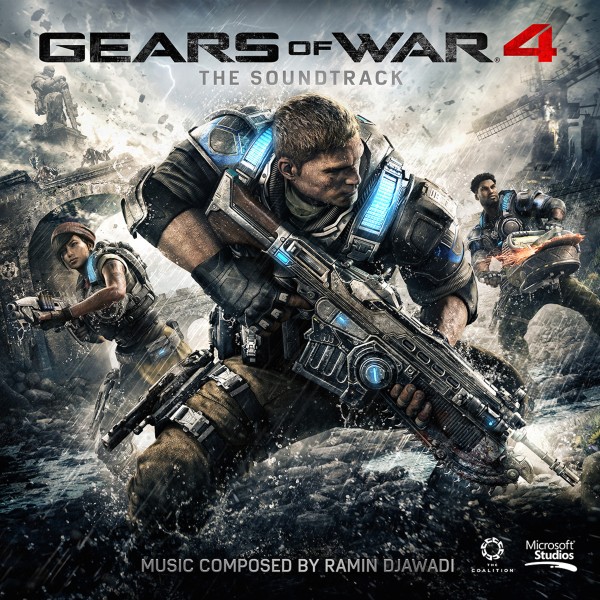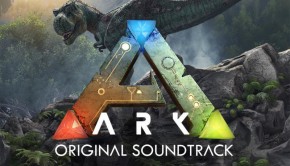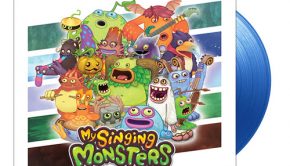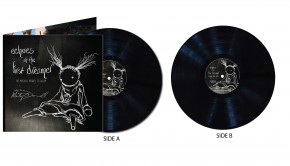Gears of War 4 Original Soundtrack
 |
Album Title: Gears of War 4: The Soundtrack |
| Record Label: Sumthing Else Music Works |
|
| Catalog No.: N/A |
|
| Release Date: October 18, 2016 |
|
| Purchase: Purchase at Sumthing |
Overview
If you haven’t heard of Gears of War 4, you’re either a huge PlayStation fan, or you’re gaming on a limited-scope console that’s become a shadow of its former 1990s glory. But seriously, it’s hard to miss such big budget games when they’re as well-advertised as a summer blockbuster. Microsoft internal dev studio “The Coalition” was created specifically to spearhead the fourth (technically, fifth) entry in the series, and they’ve polished Gears of War 4’s graphics, gameplay, and microtransaction system to a fine sheen.
However, if you haven’t heard the game, you aren’t missing much. The Coalition attempted to secure that same polish for the game’s music by hiring Ramin Djawadi—composer for Game of Thrones, Westworld, Warcraft, and an established success in film, TV, and programmatic music. But while there’s no denying Djawadi certainly has the talent to do justice where Gears of War 4’s music is concerned, after listening you may be left wondering if he had the time.
Body
The opening track, “Prologue,” is not the best start. This 50-second piece was composed to accompany the campaign’s moving, emotive, and tragedy-stricken opening cinematic. And it does so. Djawadi opens with a slow, legato string melody over a foreboding b minor chordal shift, dripping with the necessary gravitas and holding cadences. As the first phrase completes—sneaking into D major as a robust brass section enters—the track is halfway over, at exactly 25 seconds.
The brass raises the melody into the uplifting harmonic progression you’d expect after a minor-major modulation, before falling back into uncertainty. It’s also, not unsurprisingly, the same kind of cadence/chord as the one at the end of Game of Thrones’ opening theme.
This is all well and good, but as a long-time series fan, I would never know this was Gears of War. You could tell me it was the prologue music for Battlefield 1, and I’d have no reason not to believe you. Whether this issue lies with an inability to arrange the musical themes of the first few games—or with The Coalition’s inability to secure the right to those themes—it doesn’t make for the most memorable track. It’s just as somber and momentarily hopeful as you’d expect, but considering it isn’t relying on previously established musical motifs, it could stand to be a bit more adventurous.
Next we have “Anvil Gate,” written to accompany the Anvil Gate/Carlos Santiago segment of the campaign’s intro. The track sets a tense mood, with reverb-heavy, shaker-like ambiance humming behind military percussion and minor-key strings describing a foreboding ostinato. They’re joined (again) by brass. The track picks up considerably about 30 seconds in, doubling strings an octave over the brass and increasing the background percussion in sixteenth notes.
This track layers thematic g minor structures without ever really introducing a melody, which would likely be lost in the shuffle as players learn to move between cover, aim, and fire (or at least, are dazzled instead by the melody of concussive explosions and roadie running boots). After about a minute and a half of this exposition, Djawadi opens things up considerably, allowing for chordal movement beneath the now established ostinato themes and modulating through keys via chromatic passing notes. The track reaches a high point of tension, with aimless-sounding melodies searching for resolution, percussion beating faster and faster—and then it all just kind of ends, back in g minor, with a drawn-out g minor seventh chord and an explosive final beat (I think there may actually be an explosion sound layered into the mix, in fact). We’re given oodles and oodles of tension, but still no real melodic or thematic material. Maybe the next one?
In “The Raid,” we get to enjoy some much less aggressive ambiance. Super-soft strings and reeds—possibly synth pads or keyboards—float in on a bed of E minor-esque pining. They sigh, weep, and coo behind scenes of loss. Eventually, more reverberating percussion enters, and the silky-soft strings start to gain some edge. And thirty seconds later, the track just kind of ends. Again.
Finally, “Main Theme”: this is what we’ve been waiting for! Splintering hand percussion leads the charge for another ostinato string section in a minor, with brass invoking a seeking, uncertain melody that relies somewhat heavily on an “F, Eb/D#, E, A” motif. This is interesting, because if you transpose the very memorable main theme from Gears of War 2 (“Hope Runs Deep”) into the track’s a minor key, it also leans into an out-of-key D# note as the response section of its main motif.
Whether this is intentional or not, it does allow the Gears of War 4 main theme to subtly mimic the stylistic tendencies of the core series, which is a very good thing. This four-note germ warps around tense harmonic shifts, eventually repeating itself yet with the addition of—you guessed it—more percussion and more deep, rumbling brass. Djawadi regularly leaves the phrase hanging on this apparently important D#, implying an E (V chord) cadence that never shows. After moving this way for a while, the track—AGAIN—just ends on a held chord and a final staccato percussion hit.
At this point, it’s easy for me to convince myself that nostalgia for the previous games’ motifs and themes is blinding me to the Gears 4 main theme. And yet, it’s impossible to ignore the simple fact that the only “theme” in this fairly brief track is the previously described four-note section. It repeats almost note-for-note with varying levels of added instrumentation, but outside of a general unease, never speaks of further despair or fortune. How disappointing.
With “In and Out,” an electronic presence (which briefly describes that same four-note motif) gives way to synthetic percussion and a tribal beat. The Gears of War 4 motif (which we’ll call “fade” for brevity) loops throughout, at once making up background whispers and driving the main melodic movement of the strings in this track. The whining electronics and synthetic sounds combine well with the percussion and strings to evoke tension and the feeling of a pace that can’t be matched. The end of the track starts to get a little more adventurous, outlining an A-diminished chord (A, C, E-flat). If those notes sound familiar, it’s because they’re also some of the core melodic building blocks of the “fade” motif.
“A Few Snags” features tribal rhythms that continue alongside string ostinatos in g minor. In the same key and possessing almost the same instrumentation as “Anvil Gate,” it should immediately sound a bit familiar. Djawadi leans into chromatic loops that power a heady string crescendo and breaks into a pleasingly tense sixteenth-note section. The track doesn’t ever break out of this pattern, but it also doesn’t drag on too long.
In “Taken,” the music that accompanies an early campaign scene involving relatives captured by monsters (no spoilers), we’re treated to the most emotive track of the album so far. The “fade” motif returns, but is blasted out of audibility by cracking wooden percussion and screaming achromatic strings. This section at first appears as an appropriate illustration of the main characters’ dashed hopes, with their “theme” driven out of the music by much more monstrous timbres. But the motif returns again, stronger. It is layered beautifully, first in strings, then given a counterpoint in a secondary string section (which I desperately wish had appeared in the main theme originally). Brass joins and eventually transforms the motif into a hopeful “response” to the main call. Bass builds upon itself in circles while the strings step up higher and higher, eventually cadencing into a bell-like call to arms.
If you couldn’t tell, “Taken” is one of the best tracks on the album so far. Its multi-instrumental transformation of the main theme feels like the musical equivocation of the three core protagonists—Kait, JD, and Del—joining together to save their loved ones… or at least discover their whereabouts.
With “The Grave,” Djawadi severely strips things down, invoking more of an ambiance than any strict harmonic or melodic movement. Next, “The Prodigal Son,” despite the emotional implications of its title versus the subject matter in the campaign, makes ends meet via fairly straightforward electronic percussion, and more of the ever-present a minor key (and, yes, the “fade” motif again). There are moments reminiscent of some of O’Donnell’s Halo work. “The Great Escape” accompanies one of the game’s most exciting, jump-the-shark moments (again, no spoilers). Percussion and strings again imply excitement, but nothing too notable happens either.
The eleventh track, “Almost Midnight,” is as spooky as it sounds. Distortion accompanies a whispy, synthetic, wailing melody in d minor (with the “fade” motif transposed in rumbling, ponderously deep bow-drags). The motif enters on a reverb-heavy piano towards the end of the track, which then gently fades out. “Night Terrors” ups the tempo again via more tribal percussion, looping electronic sounds, and chromatically descending strings—you’ve heard all these things before, so you can probably imagine about what this one sounds like from that description. Djawadi employs his now usual method of transposing through a few keys before ending on a sudden fade-out.
“At the Doorstep” continues almost seamlessly where “Night Terrors” faded out. The mood is tense, the instrumentation sparse, and the musical material more evocative than expressive. “Rise of the Swarm” then continues almost seamlessly where “At the Doorstep” faded out, evoking mystery and tension and the ever-present motif. However, with a scant 20 seconds left, the track ramps into overdrive with new thematic material that’s very much in the mood of Jablonsky’s main theme from Gears of War 3.
“Cathedral of Pods” begins using the recently established thematic material from “Rise of the Swarm,” over a creepy, chanting chorus of voices (appropriate to the title track). Sixteenth-note string runs set up tension, while the ever-present tribal percussion drives the beat. With “Do Not Go Gentle,” we’re treated to further use of electronic ambiance, tribal drumming, and foreboding strings. The strings saw through the main notes of the second theme (D, E, F, G, Db / D, E, F, G, D#). It’s safe to assume this unsettling chromatic shuffle is the theme of the Swarm, The Coalition’s re-imagining of the series’ Locust antagonists.
With “Windflare,” the “fade” motif returns over more tribal drumming and tense, frightened strings. We’re easily a minute into this track before any semblance of melody appears, and it moves in chaotic patches before returning to the same motif. “Out of the Hive” starts up with more electronic distortion, drumming, and thrumming strings, and moves around in e minor for a while before modulating through a few keys and, suddenly, ending. Well, we haven’t had one of the “sudden” endings for a while, at least.
“Recovery,” evokes another tense mood in the soundtrack’s favored a minor key. Sad strings play a variation on the “fade” motif, replacing the diminished note (D#) with its natural form, which reminds me of the innovation in Djawadi’s established successes. The minor key itself maintains the gritty reputation that is the series’ staple, but this shift from a diminished musicality makes the minor mode sound almost hopeful; hope runs deep, as they say.
This hope-against-all-odds mood—the essence of Gears, in many ways—then employs a descending A, G, F, E melodic pattern, rich in instrumentation and emotion, echoed in vocalization, strings, and a lonely, bright piano. This note pattern is the reversal of the recently established “Swarm” theme, moving in the protagonists’ key of a minor against the Swarm’s key of d minor. It’s a musical salve, which gently sinks back into the revised “fade” motif.
With “The Storm,” we’re back into electronic and tribal percussion, rumbling/distorted strings, and tense chromatic melodic movement. This tense mood stretches out for over a minute before moving into a more hopeful setting, setting the original and revised “fade” motifs against one another in a struggle for musical dominance—not unlike the fierce battle the track accompanies.
“DB Returns” sets a somber mood via deep, drawn-out strings. A melody begins deep in the bass register, eventually giving way to the return of military percussion and the return of the revised “fade” motif played over the reversal of the “Swarm” theme. It’s a slowly moving but deeply important-sounding track, combining the major themes of the protagonists to mark a hero’s return.
With “Finale,” breathy choral vocals and soft strings set an anticipatory mood, and the long-forgotten thematic material employed seemingly only in the “Prologue” track finally returns. It’s given new life via shifting, stepping bass motion, reharmonization, and additional melodic material. This slow piece delivers oodles of emotion, eventually falling away to allow the revised motif room to echo through sonic space in in the same bright, lonely piano timbre we’re familiar with. The track allows itself to drift away, never quite achieving resolution, but implying hope for humanity nonetheless.
The final track, “A Nightmare Reborn,” is the title/menu screen music. It employs distorted percussion and echoing industrial melodies that surge and sit around the original “fade” motif, which enters only very occasionally.
Summary
There’s no denying at this point that Djawadi either did not have permission to employ or arrange the series’ original music in any way, or he chose not to. While that’s a shame for longtime fans, it wasn’t damning out of the gate—after all, it’s a new dev studio, creating new characters with new stories and new reasons to fight. Maybe they didn’t want to use the old music.
But that doesn’t excuse how downright phoned in most of this soundtrack is. Kudos to Djawadi for not only establishing motifs for the protagonists and antagonists, but layering and variating them to emotive and rewarding musical effect. However, outside of brief moments where these age-old compositional techniques are wielded successfully, the music is repetitive and unremarkable.
While motifs and memorable melodies have never been the strongest suit for the Gears of War series, it’s hard not to be a little disappointed if only because there’s so much undeveloped promise here. Djawadi seems at once torn between intelligently wielding his motifs to aurally relate the campaign’s story, and providing enough generic, tribal-drum and string infused high-action blockbuster chaff to fill the many, many stretches of time where the gameplay and visuals occupy the player’s entire attention span. Where they don’t—i.e. during cinematic events or key set pieces—Djawadi’s score has a life and a pulse, and begs to be heard.
But most of the time, this OST is—poetically enough—a faded, diminished exercise held aloft just barely by the threads of its established motifs.
Do you agree with the review and score? Let us know in the comments below!
2
Posted on November 14, 2016 by Lee Neikirk. Last modified on November 14, 2016.













